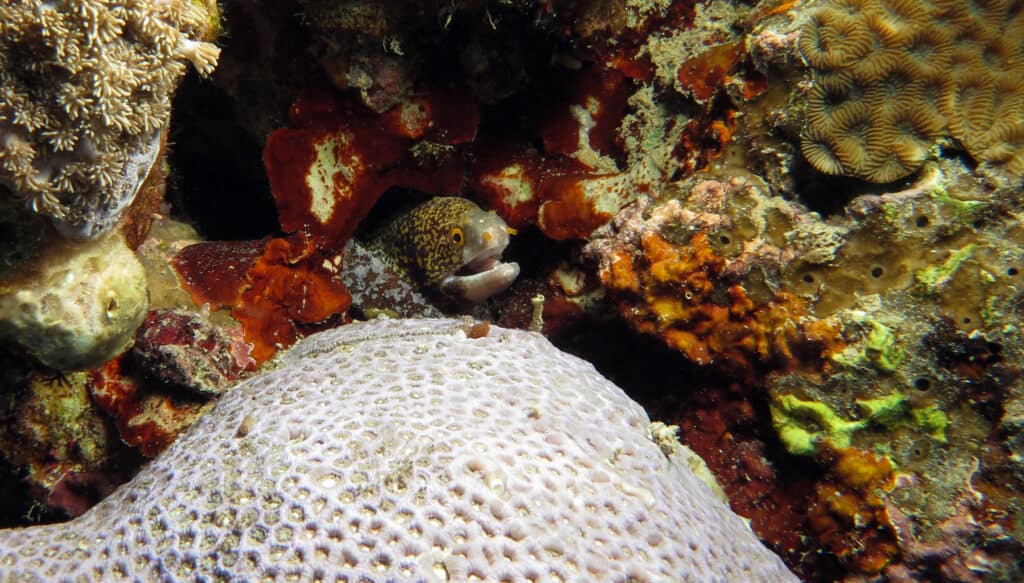Snowflake Eel
Echidna nebulosa
Snowflake Eel have two jaws to help them swallow their food.
Advertisement
Snowflake Eel Scientific Classification
- Kingdom
- Animalia
- Phylum
- Chordata
- Class
- Actinopterygii
- Order
- Anguilliformes
- Family
- Muraenidae
- Genus
- Echidna
- Scientific Name
- Echidna nebulosa
Read our Complete Guide to Classification of Animals.
Snowflake Eel Conservation Status
Snowflake Eel Facts
- Prey
- Crustaceans
- Main Prey
- Crabs, shrimp, lobster
- Group Behavior
- Mainly solitary
- Fun Fact
- Snowflake Eel have two jaws to help them swallow their food.
- Most Distinctive Feature
- They have snowflake-like speckles and stripes on their skin.
- Other Name(s)
- Clouded Moray Eel, Snowflake Moray Eel
- Temperament
- Aggressive when eating
- Habitat
- Saltwater
- Predators
- Sharks, barracuda
- Diet
- Carnivore
- Lifestyle
- Nocturnal
- Favorite Food
- Crustaceans
- Number Of Species
- 200
- Location
- African coast, Costa Rica, Columbia, Hawaii
View all of the Snowflake Eel images!
If you’ve ever wanted an eel for a pet, a Snowflake Eel may be perfect. They thrive in aquariums, spend their evenings feasting on tasty crustaceans, and love the perfect hidey-hole to relax in. These eels can get up to 40 inches long, so they need plenty of space. But they make a fantastic addition to a large saltwater aquarium.
Snowflake Eel Facts
- Snowflake Eels are known by the name puhi-kapa in Hawaiian.
- They do not have scales to protect their skin, instead relying on mucus secretion.
- If you want to have a Snowflake Eel for a pet, you will need a tank that is at least 75 gallons big, preferably more!
- Snowflake Eels can change their sex as needed.
- These eels have two sets of jaws.
Classification and Scientific Name
The scientific name of the Snowflake Eel is Echidna nebulosa. It is also known as the Clouded Moray Eel or the Snowflake Moray Eel. It is a member of the Echidna genus, which also includes 10 other species. They are all classified as Moray eels.
Moray Eels belong to the Muraenidae family. These eels are all carnivorous eels, although they do not all live in the same type of water. Most live in saltwater but some of the 200 species within the family live in brackish water and a few live in freshwater. There are 15 genera within the Muraenidae family.
They are part of the Anguilliformes order, which includes all eels. All eels have elongated bodies and most have fused fins that run the majority of the length of their body. They belong to the Actinopterygii class, which designates them as ray-finned fish. This type of fish has fins that are supported by bony structures, or rays. While eels have a unique appearance among ray-finned fish, they are still classified in this group. They are part of the Chordata phylum and Animalia kingdom.
Snowflake Eel Appearance
The largest Snowflake Eels can be up to 40 inches long. However, it is more common for Snowflake Eels to be closer to 20 inches long. It is dark yellow, black, and brown with stripes of speckles. This helps it blend in with its surroundings in the ocean. Like many species of eel, their dorsal fin is fused. It runs along the entire length of their body.
Many Moray eels, including the Snowflake Eel, have two jaws. The second set of jaws is called the pharyngeal jaws. This second set of jaws helps the eel swallow its prey. Most fish use suction to press their food down so that it enters the digestive system. These eels are unable to do this, likely because of their environment and feeding habits, so they evolved to have an extra set of jaws. They use their first set and teeth to capture their prey and the second set to pull the food back and into their digestive system.
Unlike other fish, Snowflake Eels do not have scales. Instead, they create mucus that acts as a barrier on the outside of their skin. Snowflake eels do have sharp teeth, something to keep in mind if you decide to have a Snowflake eel as a pet. They do thrive in aquarium settings, as long as the aquarium is large enough for their size.

Hiding in coral, the Snowflake Eel waits for its prey to move nearby.
©Paulo Violas/Shutterstock.com
Distribution, Population, and Habitat
Snowflake Eels live in the wild in the Pacific Ocean and parts of the Indian Ocean. They can also be found in the Red Sea. Snowflake Eels have been spotted off the coast of parts of Africa, many of the small islands of Micronesia, near the Baja Peninsula, Costa Rica, and Colombia. They are also in aquariums around the world because they do so well in captivity.
These eels are found in Hawaii. Their name in Hawaiian is puhi-kapa. Puhi is the name given to all moray eels, some of which are very common in the waters around the Hawaiian Islands. At the Kalaupapa National Historical Park off the coast of Molokaʻi, puhi-kapa are present but uncommon. On the other hand, the Stout Moray (Gymnothorax eurostrus), or puhi, is listed as abundant in the park.
They live in reefs and seagrass beds, where they can blend into the environment. Like other eels, they like to burrow in holes. Snowflake Eels can live in shallow water, as little as 3 feet. They can also survive at higher depths, up to almost 150 feet. They need plenty of places to hide in order to feel comfortable. In the wild, they find this in their natural habitat. For eels that live in aquariums, their caretakers need to provide these places and setups.
Predators and Prey
Snowflake Eels are carnivorous and have sharp teeth that they use to take down prey. Their favorite food is crustaceans, such as shrimp and crabs. They can even eat lobsters. Their teeth are ideally shaped and situated to crunch down on the hard shells of these prey. Clams and mussels, octopus, scallops, and squid also make great food for Snowflake Eels.
These eels use their sense of smell more than their sense of sight to find prey. Their eyesight is quite bad and they have to rely on scent to get something to eat. Snowflake Eels have two sets of nostrils to help heighten this sense. They feed at night and are much more active during this time.
If you are taking care of a Snowflake Eel in an aquarium, you can feed them a similar diet to what they would get in the wild. Most eels prefer live or fresh prey rather than frozen, although they can get used to the frozen variety over time. Make sure not to feed Snowflake Eels fish such as goldfish or put them in the tank with these fish. They can make them sick. They should also not be in a tank with potential prey, since Snowflake Eels can get aggressive when it comes to food.
Larger carnivorous fish are typically the only other species in the ocean that would prey on a Snowflake Eel or other type of Moray eel. Examples include sharks and barracuda. Snowflake Eels are also caught by humans for use in aquariums, although some people prefer to breed Snowflake Eels.
Reproduction and Lifespan
Snowflake Eels can live between 5 and 15 years in captivity. They are considered a pet to keep for the long haul, unlike some other species of fish that do not live nearly as long. They do need to have a large enough tank, however. It should be at least 75 gallons and even bigger if possible.
In the wild, Snowflake Eels likely live shorter lives. This is due to predators in their environment, competition for food with other fish, and general hazards. They are not considered endangered.
Snowflake Eels are protogynous, meaning that they can change their gender. When two eels are together, one will usually change to male while the other will be female. This can take a few months, however, and is something to consider if you are keeping multiple Snowflake Eels as pets or breeding them.
When they lay eggs, Snowflake Eels scatter them in the water. They eventually sink to the bottom of the sea floor when they are ready to hatch.
Snowflake Eel in Fishing and Cooking
People do not actively fish for or cook Snowflake Eel. The blood of eels is poisonous and can make you sick. However, when you cook it, the blood is rendered harmless. Even so, Snowflake Eel is not a common fish to eat. A few places do cook and serve Moray eel, but even that is rare. Because it can make you sick, most people stay away from it.
Instead, Snowflake Eels are much more common to catch for use in aquariums. They make a great pet that does very well in aquariums. They do need a large tank, at least 75 gallons. You should also take care not to put them with potential prey because there is a good chance that they will eat them. Even though they do not typically eat small fish in the wild, they will probably do so if given the chance in the confined environment of an aquarium.
Pet Snowflake Eel sare also notorious for escaping their tanks. They like to hide and will do so in the most unlikely of places. This includes the filter or strainer, as well as near the lid of the tank. They will even push the lid off and jump out of the water to escape. It’s best to assess your tank setup for any potential ways to get out and make sure that they are blocked. This includes getting a lid that latches or locks.
Similar Fish to Snowflake Eels
View all 293 animals that start with SSnowflake Eel FAQs (Frequently Asked Questions)
How many Snowflake Eels can I have?
In one aquarium, it’s best to keep up to two Snowflake Eels as long as the tank is large enough to support both fish. It is also important that they are added to the tank at the same time so that they do not get aggressive with each other. They should also be roughly the same size.
What can be kept with a Snowflake Eel?
Large fish, such as a Lionfish or Tang, are the best companions for Snowflake Eel. You should avoid putting potential prey, such as crustaceans, in with your Snowflake Eel. Small fish should also be avoided because some can make the eels sick if they eat them.
Are Snowflake Eels good for beginners?
If you are setting up your very first saltwater aquarium, a Snowflake Eel is a good fish to add as long as the tank is large enough to support them. You should also consider what other companion fish you plan to put in your aquarium and if a Snowflake Eel would make a good addition. Otherwise, they are easy to keep and feed.
Thank you for reading! Have some feedback for us? Contact the AZ Animals editorial team.
Sources
- The Spruce Pets, Available here: https://www.thesprucepets.com/snowflake-eel-profile-2920906
- Build Your Aquarium, Available here: https://www.buildyouraquarium.com/snowflake-eel/
- Kalaupapa National Historical Park, Available here: http://www.botany.hawaii.edu/basch/uhnpscesu/htms/kalafish/family/Muraen.htm

















